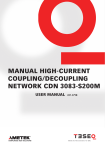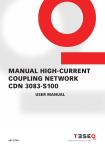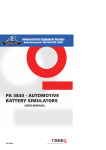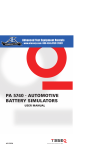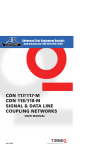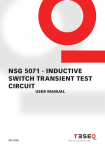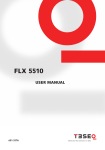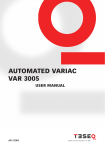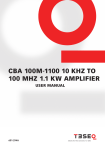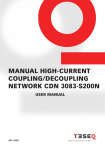Download 601-319B - AES 5501 User Manual english.indd
Transcript
1 aes 5501 automotive emissions system User Manual 601-319B AES 5501 Automotive Emissions system User Manual AES 5501 - Automotive Emissions System contentS 1. Explanation of symbols used in this manual 2. Warning symbols on the test system 3.Safety 4.Installation 4.1 Connecting the power cable 5. Introduction to emissions in ISO 7637-2 6. The AES 5501 - Automotive Emissions System 6.1 The system controller 6.2 Mechanical switch 6.3 Artifical network & shunt resistor 6.4 Electronic switch 6.5Timing 6.6 Trigger source 7. The MS 5501 8. The AN 5501 9. The ES 5501 Electronic switch 10.Operation 11. Specifications 12. Technical data 13.Maintenance 13.1Cleaning 13.2Calibration 13.2.1 Calibrating the AN 5501 13.2.2 Calibrating the ES 5501 14 The package contents 15 Declaration of conformitiy (CE) 16Addresses 5 7 8 10 10 11 14 15 15 16 16 16 16 17 26 29 30 33 36 37 37 37 37 37 38 39 40 1 explanation of the symbols used in this manual Please take note of the following explanations of the symbols used in order to achieve the optimum benefit from this manual and to ensure safety during operation of the equipment. The following symbol draws your attention to a circumstance where failing to observe the warning could lead inconvenience or impairment in performance. Example: This connection must not be confused with the main power input. The following symbol draws your attention to a circumstance where failing to observe the warning could lead to component damage or danger to the operating personnel. Caution sign: A situation that may cause damage to the equipment Example: Connect the system only to rated mains power. 5 6 Danger sign: Possibly dangerous situation that may cause damage to persons or heavy damage to the test equipment or DUT. Example: It is dangerous to fail to observe safety warnings. AES 5501 - Automotive Emissions System 2WArning symbols on the test system CAUTION! Warning of a danger spot (refer to the documentation). 7 8 3SAFETY The AES 5501 system itself contains no dangerous voltages or currents, however, the application requires an external power source and can use up to 100 A for DUT power. Up to 100 A may be switched using the AES 5501. Care should be taken in connecting and operating the DUT. The AES 5501 system is used to measure emissions from the DUT. These emissions may be high voltages caused by inductive kickbacks. Care should be used when powering the DUT through the AES 5501 system. Refer to engineering or product documentation for your specific DUT. Potentially dangerous voltage may be present at the cables leading to and from the DUT. Take care and follow all applicable safety guidelines given for your specific DUT. General warnings. DANGER! It is imperative that you read the following safety instructions and all safety instructions in the manuals of the connected peripheral systems before installing and starting this test system for the first time. AES 5501 - Automotive Emissions System DANGER! The electrical and mechanical safety equipment must not be removed, put out of operation or bypassed. Handle all safety equipment with care. If a safety device should be broken or is not working, the system must be put out of operation until the safety device is repaired or exchanged and fully in working order again. DANGER! HAZARDOUS AREA! Connectors on the test equipment should not be touched! The equipment may only be operated within an area that is explicitly declared a “Test Floor” (with appropriate signs) and protected against improper acces. It is important to power off the DUT before disconnecting the DUT or any parts of the AES 5501. The operating instructions form an integral part of the equipment and must be available to the operating personnel at all times. All the safety instructions and advice notes are to be observed. 9 10 4Installation 4.1 Connecting the power cable The power supply is an auto ranging type. For exact specifications, see the section technical specifications. Please only use power cables that are certified for use in your location. Connecting the power cable For further information on cabeling and setup please see the section “Operation”. AES 5501 - Automotive Emissions System 5Introduction to emissions in iso 7637-2 The AES 5501 is designed in accordance to ISO 7637-2 and may be used with confidence for many manufacturer standards. This guide gives a good overview of ISO 7637-2. Carefully consult the relevant manufacturer standard and ISO 7637-2 before operating the AES 5501 system. ISO 7637-2:2004 describes a method of measuring transient returns from a DUT when the battery is switched on or off. This standard is an important part of automotive EMC testing. This standard describes two methods of switching the DUT: with a mechanical switch (recommended the actual switch built into the vehicle) or a fast electronic switch. Refer to the applicable annex of ISO 7637-2 for guidance in measuring the returned effects, and limits. Pay special attention to cable lengths. The standards have strict cable length requirements. The most common are provided with the AES 5501 system. ISO 7637-2 recommends two setups. The switch can be before or after the AN as seen in the following diagrams. Refer to ISO 7637-2 for more information. 11 Oscilloscope 12 Switch Artificial Network Simulates Wiring Harness Impedance DUT Battery Source Slow pulses (ms range or slower) DU T Wiring Harness Application for “Slow” pulse showing most of the wiring harness impedance between the switch and DUT. AES 5501 - Automotive Emissions System 13 D UT Wiring Harness Application for “Fast” pulse showing most of the wiring harness impedance between the battery and switch. Oscilloscope Artificial Network Simulates Wiring Harness Impedance Battery Source Fast pulses (ns to μs range) Switch DUT 14 6The aes 5501 - automotive emissions system The AES 5501 is a system of electronic and mechanical switches, an artificial network, and a unique control station designed for emissions testing to ISO 7637-2. Consisting of a four-part solution, the user has complete control over where, when and how the switches can be placed and controlled, including the necessary drive voltages for the relays. The 100 A connectors are carefully placed and countersunk to allow precise cabling between the switches, the artificial network and test bench and allows for the electronic or mechanic switches to be placed at any point before or after the artificial network. This careful attention to switch placement and cable length means that the numerous manufacturer standards can also be met. The AES 5501 features a rugged construction with unpainted underside for good earth contact, precise switching control and monitoring functions. A counter for the relay and LED indicators for both electronic and mechanical electronic switches are provided. The ES 5501 has temperature controlled fans for quiet operation and a thermal shutdown feature. The AES 5501 AES 5501 - Automotive Emissions System 6.1 The system controller The system controller SC 5501 is used to control timing and provide the necessary voltages for the AES 5501 system, and provide a convenient method of selecting the various functions.. The SC 5501 The SC 5501 is broken into several fields depending on their functions: Mechanical switch, artificial network & shunt resistor, electronic switch, trigger source and timings. The following sections will provide details about these various control elements. 6.2 Mechanical switch The mechanical switch field is used to control the MS 5501 and contains three input elements: buttons named triggered, Off and On. In “Off” mode, the switch is turned completely off, thus blocking any DC voltage to the DUT. In “On” mode, the switch is turned on, thus providing any DC voltage available at the input of the mechanical switch to the DUT. Trigger mode is the mode by which the user has the ability to control the timing of the switch using the fields timing and trigger source. This field also has an LED display that shows the status of the switch. The switch will indicate green when it is on (conducting), and unlit when off. red indicates an error condition. Pressing the unlit indicator will select the mode. Refer to the descriptions of the timing field and trigger source fields below. 15 16 6.3 Artifical network & shunt resistor This field allows the user to select the impedance of the artificial network. Selecting the resistance here will set the resistor on the left (input) side of the artificial network to the selected value, as shown on the AN 5501. Selecting the Off/Exernal option, will connect the resistor to the banana jacks on the left (input) side of the AN 5501. For more details, consult section 8. 6.4 Electronic switch The electronic switch field is used to control the ES 5501 and contains three input elements: buttons named Triggered, Off and On. In “Off” mode, the switch is turned completely off, thus blocking any DC voltage to the DUT. In “On” mode, the switch is turned on, thus providing any DC voltage available at the input of the mechanical switch to the DUT. Trigger mode is the mode by which the user has the ability to control the timing of the switch using the fields timing and trigger source. This field also has an LED display that shows the status of the switch. The LED will indicate green when it is on, and unlit when off, and red indicating an error condition. Pressing the unlit indicator will select the mode. Refer to the descriptions of the timing field and trigger source fields below. 6.5 Timing The timing field is used to select the battery off, and battery on times. The battery on time is only valid when the trigger source is set to Internal. The battery off time is used only when trigger source mode is internal or single. Both the battery off and battery on times may be set using the included dials between approximately 10 ms and 10 s (see specifications for exact timings.) 6.6 Trigger source The trigger source is used to select the source and mode of the switching timing. In “internal” mode, the timing of both repetition and disconnection is selected with the dials provided in the timing field of the SC 5501. AES 5501 - Automotive Emissions System In “single mode”, the timing of the pulse will be selected by the battery off (TOFF) dial in the timing field of the SC 5501. There will be no repetition in single mode. To activate a pulse, press the trigger button under the “single” button when selected. In “manual” mode, the timing is dependant on how long the trigger is depressed. To start a pulse (battery voltage off), depress the trigger button (under the manual button) with manual selected. To end the pulse (allow battery voltage to the DUT), release the trigger button. In “external” mode, the user supplies a TTL signal on the BNC located at the back side of the SC 5501. The battery output will follow the signal: A high input to the trigger in BNC will result in battery voltage available to the DUT (selected switch ON). The input signal may be between ~4.5 and 12 V and is a differential input. Control cables (Interchangeable) Trigger in Trigger out Connectors on the SC 5501 17 7 The MS 5501 The MS 5501 is the container of the mechanical switch (relay). 125 m m 50 mm 18 The MS 5501 The MS 5501 is delivered with a 100 A relay. Refer to section 6 for control. The 100 A relay may be exchanged using the supplied PCB for other relays that use the industry standard footprint. Before using the MS 5501, you must connect the control cable from the MS 5501 to the SC 5501. The relay control voltage is provided from the SC 5501, as well as all timing functions. The MS 5501 contains an counter and BNC connector for ease of use. The counter will indicate the number of pulses that have been sent from the SC 5501. Note that even if the repetition frequency is too fast for the mechanical switch to react, the counter will still count the pulses. . The counter counts the control pulses that are sent from the SC 5501, even if the timings are too fast for the electromechanical switch to react. Resetting the counter may be performed by pressing the provided button inside the MS 5501. Normally this is done when replacing the relay. AES 5501 - Automotive Emissions System 19 Resetting the counter The MS 5501 is provided with a 100 A relay installed by default. The PCB adapter with a selection of industry standard footprints may also be installed by performing the following steps. Opening the housing should be achieved by removing the four thumb screws indicated in the following picture and gently lifting the handles outwards and upwards. Opening the housing 20 Removing the housing cover The old relay must be removed. Start by removing the cables connecting the relay to the input and output posts (high side only) using a 10 mm wrench. This will be performed two times, on the input and output sides of the MS 5501. AES 5501 - Automotive Emissions System The system should appear as in the following picture when the relay is removed: Uninstalled 100 A relay 21 22 It should never be necessary to remove the negative connections inside the MS 5550. The AES 5501 was designed, in accordance to the standards, to open only the positive battery lead. Reinstalling the 100 A relay may be achieved by reversing the above steps. Installing the included PCB with standard relay footprints may be installed using the following process. Install the supplied studs and the PCB using the supplied hardware a screwdriver with T25 bit. Install the relay PCB The studs will require the use of washers (included) between the base of the ES 5501 and the stud. AES 5501 - Automotive Emissions System The PCB containing the relay sockets uses two studs included with the AES 5501 system. Next, connect the included cabling. This includes two sets: two short battery cables, and a six-pin cable. The six-pin cable provides the necessary drive voltages to the relay. Take care when installing this cable. The two red battery cables should be connected from the battery studs to the common and normally open connections as shown. 23 24 Next you will need to select the voltage for your specific relay. The included Bosch relay is part number 0 332 019 151 and uses a 12 V drive voltage. The AES 5501 system was designed to include 12, 24 and 42 (36) volt drive voltages to the relay. The voltage for the relay comes over the short six pin cable and is selected as shown in the following picture. Selecting the drive voltage AES 5501 - Automotive Emissions System Carefully select the drive voltage of the relay installed before connecting the drive cable to the MS 5501. Degradation in performance or damage may result in incorrectly selected drive voltages. The limitation in the supplied Bosch relay is 30 A. If another relay is installed, the entire system’s performance must be adapted to the relay current. The MS 5501 may be closed again using a reverse process of that given above, and reconnecting the six screws and the drive cable from the SC 5501. Please note that the coil suppression diode is required. Mind the polarity of the diode when exchanging relays. 25 26 8 the an 5501 The AN 5501 contains the artificial network rated to 100 A, the necessary selectable impedance, an extra banana connector for external impedances and an output connector for monitoring if necessary. The AN 5501 The AN 5501 shall be connected to the SC 5501 using the supplied control cable. As in any of these external chassis, it is not important which cable is connected; any of the three available may be used. To select the RS resistor, choose the appropriate resistance value on the SC 5501. If an external resistor shall be used, selecting off/external on the SC 5501 will activate the Ext. R connector. Pay attention that a resistor of sufficient power is used based on your battery voltage using the following formula. P = U2/R AES 5501 - Automotive Emissions System Where P is the resistor power, U is the battery voltage and R is the resistor value in Ohms. When an external resistor is used, care shall be taken to select a resistor value of sufficient power to withstand the battery voltage. The AN 5501 contains a jumper for connecting the negative battery input terminal to ground. This should be left connected usually (and is required for conformance to ISO 7637). The output side of the AN also contains a special connection for the calibration adapter. This can be ignored during daily use. The ground jumper Mating surface for the calibration adapter 27 28 The AN 5501 also has a place for connecting a resistor when using the external setting on the SC 5501. While most common impedances are included in the AN 5501, these banana connectors can be used for additional RS shunt resistors. The external Rs jacks AES 5501 - Automotive Emissions System 9 the es 5501 electronic switch The ES 5501 is the container of the electronic switch with specifications outlined in ISO 7637-2. The ES 5501 The ES 5501 is a 100 A fast electronic switch. Refer to chapter 6 for control. Before using the ES 5501, you must connect the control cable from the ES 5501 to the SC 5550. The ES 5501 contains a BNC connector for ease of use. 29 30 10operation In every case, it is important to consider where the input and outputs of the system are. The input is always to the left of the various chassis, and the output is on the right. The cables are exchangeable, as is the positions of the switches, as long as the inputs and outputs are observed. The AES 5501 Emissions system In the above example (here shown with both switches) the DC voltage (battery) comes in the left side and the DUT would be connected on the right. AES 5501 - Automotive Emissions System Carefully observe cable placement, observing maximum cable lengths and cable placing requirements of your standard. It is important to observe proper polarity when connecting the oscilloscope probe. Most oscilloscope probes have a ground connection. The AN 5501 is not isolated and failing to observe proper polarity can cause a short of the power supply to ground! Once all cables are in place and the various lengths of cables are observed, provide the DC voltage to the DUT by switching both the Mechanical Switch and Electronic Switch to “On”. The AES 5501 can also be used with the supplied pins. The allows the user to effectively have zero distance between the AN and switches. The AES 5501 being configured for zero cable length 31 32 Next, select your RS by selecting the resistance value on the SC 5501. To perform the slow pulse, for example, select the Mechanical Switch -> Triggered, and use either the Manual, Single, Internal fields to select the timing. Any switch in the DC path must be selected “ON” or “Triggered” or “DC” will not pass to the DUT. All switches in the DC path must be set to “On” or “Triggered” or no battery will be available to the DUT. Throughout the system, a green LED means DC switched on, a red LED indicates an error condition, and an unlit LED indicates that the switch is switched off. Cable lengths are strictly required by most standards, as is the cable height above the ground plane. Observe these restrictions carefully for a compliant test. After all of your cables are connected and the DUT is powered through the switch(es) then you are ready to create a dropout. Note that the worst emissions returns usually occur at the time of switching the voltage off due to inductive kickback. AES 5501 - Automotive Emissions System 11Specifications Complete system1: Electronic: Mechanical switch: Artificial network: Connectors: Housing: Battery current 100 A Inrush current 2 300 A for 200 ms Battery voltage 0 to 60 VDC Shunt resistor (RS) 10, 20, 40, 120 Ω, Ext. Trigger modes External, internal, single, manual Battery off time (TOff ) 10 ms - 10 s ± (10% + 10 ms) Battery on time (TOn) 0.5 - 10.5 s ± (10% + 10 ms) Mains input voltage 85 - 264 VAC, 47 - 63 Hz Available relay 12, 24, 36V (for 42 V voltage applications) Switching time Δts 300 ns ± 20%3 Voltage drop <1 V @ 25 A Typ. < 2.1 V @ 100 A Transient voltage > 440 V protection Type Automotive relay Contacts High purity AgNi with no suppression across contacts Voltage rating > 400 V Inductance 5 μH Capacitance 0.1 μF Resistance 50 Ω Impedance As per ISO 7637-2 see above impedance curve 100A MC type, countersunk, 50 mm above ground plane Stainless steel, unpainted underside, screw terminal and earth connections 33 34 Indicators: Measurement: Ports: Counter on relay, LED indicator on controller for mechanical and electronic switchs MS 5501, ES 5501 - directly connected to output AN 5501 - 5.6 k output impedance (to output connector - necessary for improved RF performance) All tolerances ± 10% unless otherwise noted. 1) Active, temperature dependant cooling. The ES 5501 is depending on duty cycle, approximately 3 minutes at 100 A with 100% duty cycle before the switch will be deactivated for cooling. See derating below. 2) With supplied relay or Electronic Switch 3) With test load defined in ISO 7627-2. Purely resistive loads display typically in the range of a few microseconds. ES 5501 switching curve with test load AES 5501 - Automotive Emissions System 35 60 50 40 Z[Ω] PB │ 30 20 10 0 0.1 1 10 Impedance curve of the AN 5501 100 f [MHz] Derateing ES 5501 Ion (100% Duty Cycle, @25°C) [A] 100 95 90 85 80 75 70 65 60 0 10 20 30 ON-Tim e [m in] Current capability of ES 5501 40 50 60 36 12Technical data Mains voltage: Power (max.): Fuse: 85 ... 264 VAC 100 W 2 x T 3.15A Environmental conditions Temperature range Operation at: Storage at: Humidity: Air pressure: +10 to +40º C -10 to +60 º C 30 to 78% (non condensing) 860 to 1060 hPa Dimensions and weights Physical Dimensions (L x W x H): MS 5501 AN 5501 Weight: MS SC 5501 AN 5501 ES 5501 125 x 125 x 125 mm 125 x 125 x 125 mm 340 x 270 x 205 mm ES 5501 3.4 kg 2.4 kg 2.9 kg 10 kg AES 5501 - Automotive Emissions System 13Maintenance Except for the relay in the MS 5501, there are no user serviceable parts inside. For fuse selection, please see the section on technical data. 13.1 Cleaning Cleaning the AES 5501 should be performed using only a clean, dry cloth. No detergents of any kind are recommended. 13.2 Calibration The AES 5501 has two parts requiring calibration: The ES 5501 and AN 5501. 13.2.1 Calibrating the AN 5501 Calibration of the AN 5501 is performed using the calibration kit INA 5500-CK which provides a shorting connector for the input side and a MC to N-Type connector for the output side where the network analyzer is connected. The grounding plug must be in place during calibration. For more details on calibration, see the calibration procedure and documentation included in the INA 5500-CK. 13.2.1 Calibrating the ES 5501 Calibration of the ES 5501 is performed using the test load defined in ISO 7637-2. This is available under model number INA 5500-TL. The switching time of 300 ns is only valid using this load. Resistive loads and open circuit measurement will be different. 37 38 14The package contents Inside the packaging, you will find the following items: 1 x MS 5501 Mechanical switch 1 x ES 5501 Electronic switch 1 x SC 5501 System controller 3 x Control cables Calibration certificate Users guide (this guide) Oscilloscope probe compliant to ISO 7637-2 4 x Pin adapters (for zero millimetres between devices) 4 x 4 to 6 mm adapters 2 x Alternative relay PCB, cable and hardware AES 5501 - Automotive Emissions System 15Declaration of conformity 39 Headquarters Teseq AG 4542 Luterbach, Switzerland T + 41 32 681 40 40 F + 41 32 681 40 48 sales @ teseq.com www.teseq.com Manufacturer Teseq AG 4542 Luterbach, Switzerland T + 41 32 681 40 40 F + 41 32 681 40 48 sales @ teseq.com China Teseq Company Limited T + 86 10 8460 8080 F + 86 10 8460 8078 chinasales @ teseq.com France Teseq Sarl T + 33 1 39 47 42 21 F + 33 1 39 47 40 92 francesales @ teseq.com Germany Teseq GmbH T + 49 30 5659 8835 F + 49 30 5659 8834 desales @ teseq.com Japan Teseq K.K. T + 81 3 5725 9460 F + 81 3 5725 9461 japansales @t eseq.com Singapore Teseq Pte Ltd. T + 65 6846 2488 F + 65 6841 4282 singaporesales @ teseq.com Switzerland Teseq AG T + 41 32 681 40 50 F + 41 32 681 40 48 sales @ teseq.com Taiwan Teseq Ltd. T + 886 2 2917 8080 F + 886 2 2917 2626 taiwansales @ teseq.com UK Teseq Ltd. T + 44 845 074 0660 F + 44 845 074 0656 uksales @ teseq.com USA Teseq Inc. T + 1 732 417 0501 F + 1 732 417 0511 Toll free +1 888 417 0501 usasales @ teseq.com © December 2010 Teseq® Specifications subject to change without notice. Teseq® is an ISOregistered company. Its products are designed and manufactured under the strict quality and environmental requirements of the ISO 9001. This To find your local partner within document has been carefully checked. Teseq®’s global network, please go to However, Teseq® does not assume www.teseq.com any liability for errors or inaccuracies.








































